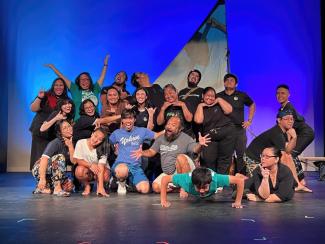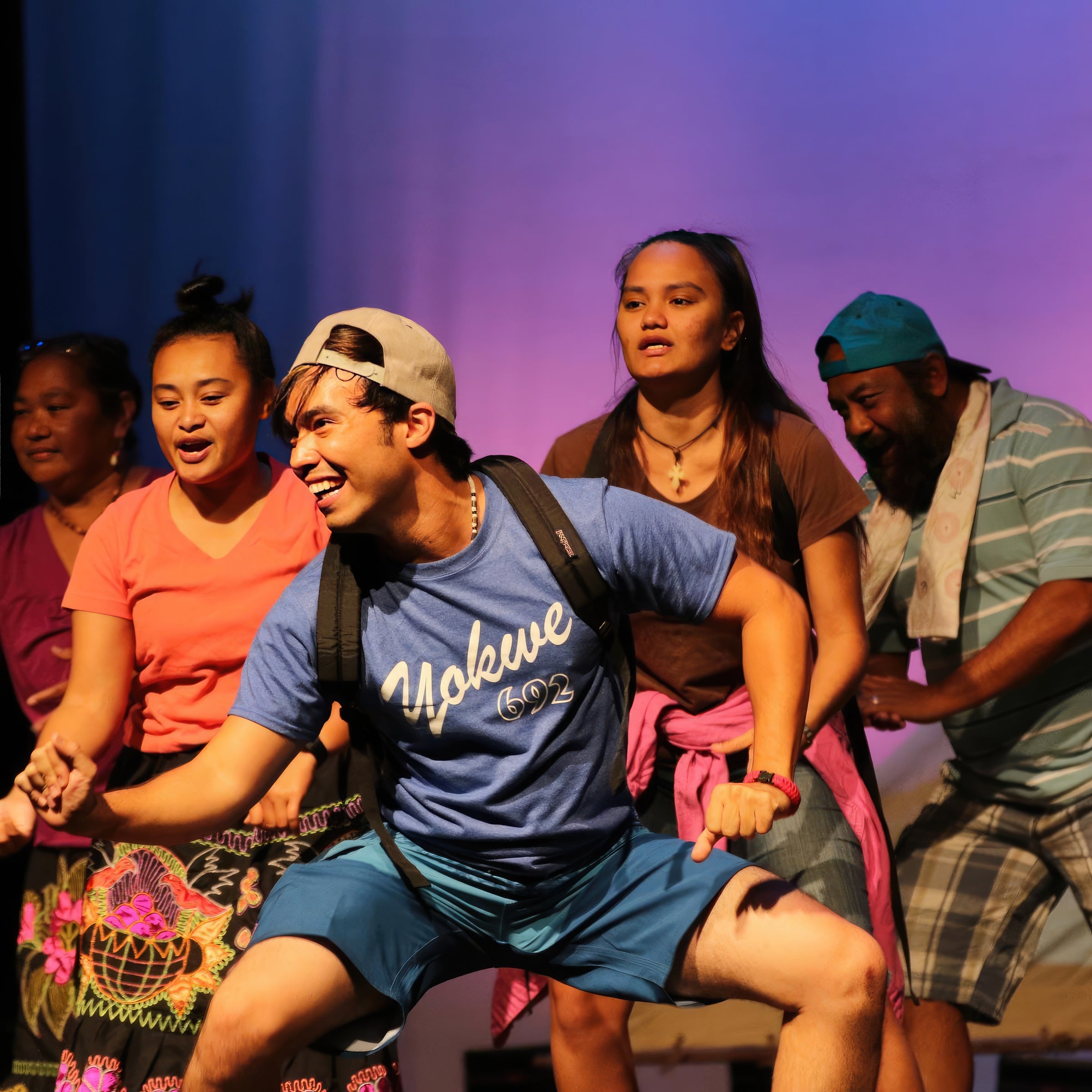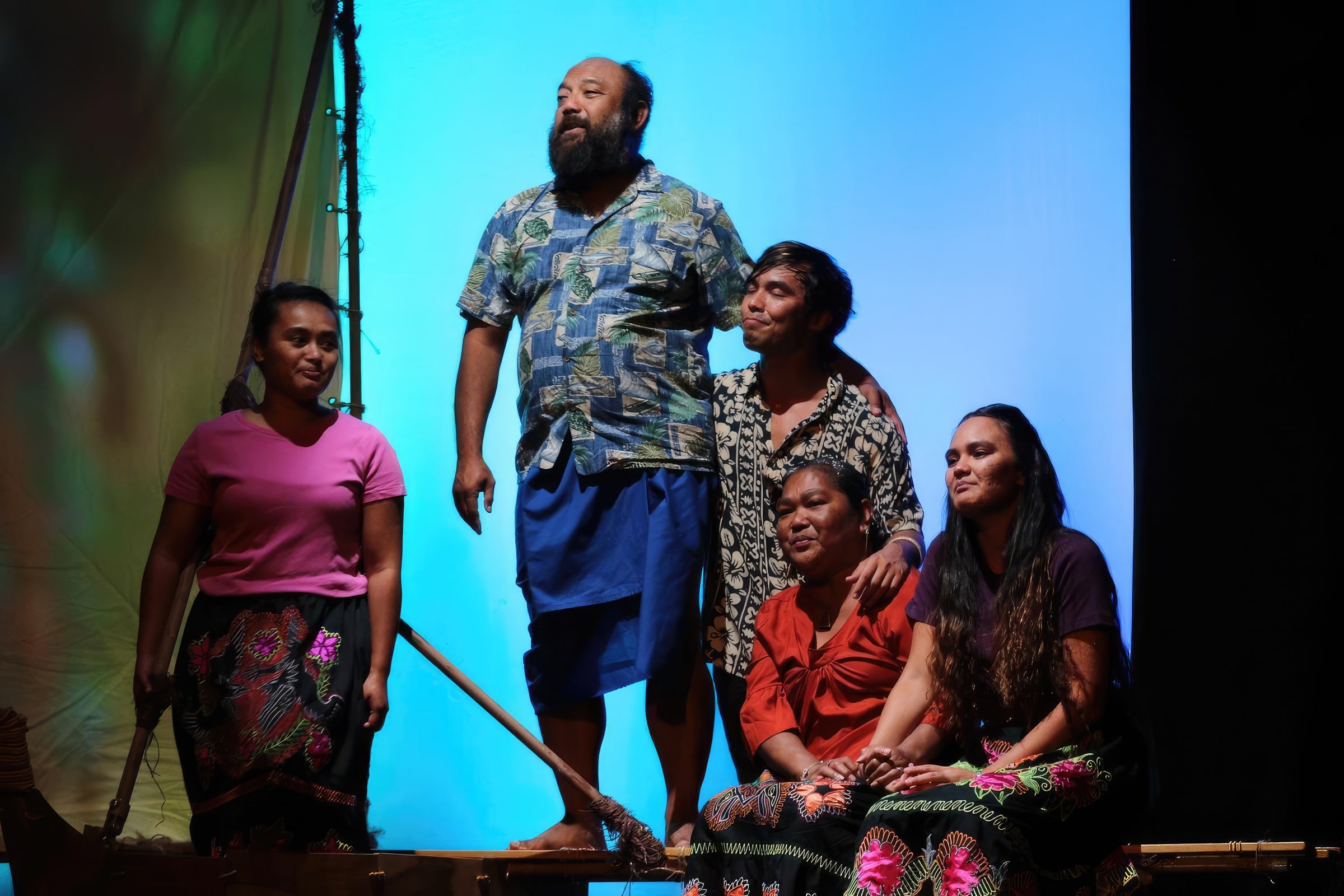
In the Mariåna Islands, there is a word in the Chamorro language for a deep feeling of longing— mahålang. Mahålang has several translations, including the feeling of being lonely, missing someone, something, or some place; homesick. Growing up as a Chamorro in the continental United States, I always had this feeling of mahålang. Longing for a place I was not in, longing for a sense of belonging, longing for community. It was a deeply rooted, subconscious longing and missing of something I didn’t know how to define. I didn’t realize what I was longing for until I returned to my mother’s home island of Saipan in 2021 after years of being away.
I returned to the house my grandparents built and raised their five children in, tucked in the small village of Chalan Piao on the southern side of the island. A lush agri-jungle, as my grandpa calls it, the land is plentiful in local plants and trees—mannga (mango), bilembines (star fruit), åtes (custard apple), niyok (coconut), lemmai (breadfruit), aga (banana). A garden, started by my late Grandma Lou and nourished now by my Grandma Evelyn, blesses the front of the house with a sweet, floral aroma. When it rains in Chalan Piao, the smell of the earth becomes extra palpable. I would sit in the driveway with my cousin at night and we’d look up at the moon together, discussing family and culture and land and responsibility. She would tell me taotaomo’na stories.
 Scenes from performances by the Breaking Wave Theatre Company. Photos courtesy of Breaking Wave Theatre Company.
Scenes from performances by the Breaking Wave Theatre Company. Photos courtesy of Breaking Wave Theatre Company.
Taotaomo’na translates to the “people of before.” In the islands, they’re known as spirits. Some protect you, some tease you. The Chamorro Peoples have a long history of venerating ancestors. We believe that your spirit doesn’t leave when you pass on. At night, their presence becomes more known—they are most active at dusk or dawn. The humid night air, thick with the aroma of the garden and the sweat of the earth my grandparents built our family home on, unlocks my soul. My heart beams, this is home. The smell in the night air when it rains in Saipan speaks to the feeling of mahålang I have always wanted to satisfy.
Many Chamorros travel away from home; the Chamorro People indigenous to the Mariåna Islands have a long history of migration. The archipelago of 14 islands, located in the northern Pacific Ocean, was first populated thousands of years ago by navigators. Now, only the four southernmost islands are permanently populated: Guåhan, Rota, Tinian, and Saipan. Throughout history, Chamorros would travel between islands within the Mariånas for trade, resources, and family (my grandparents currently go back and forth between Saipan and Guåhan). The Chamorro people have been resilient through Spanish, German, Japanese, and American colonization, traveling to different corners of the global empires controlling our islands. Today, we have a far-reaching diaspora with Chamorros around the world.
 Scenes from performances by the Breaking Wave Theatre Company. Photos courtesy of Breaking Wave Theatre Company.
Scenes from performances by the Breaking Wave Theatre Company. Photos courtesy of Breaking Wave Theatre Company.
When the wind fills our sails, how do we stay connected to home? As a diasporic Chamorro who was raised in California, has lived in the Mariånas, and attended theater school in Boston, I have grown accustomed to being mahålang. The further I travel, the more longing for community I have—searching for a community who shares the same feeling of mahålang as I do.
I have found a strong community that transcends location through Breaking Wave Theatre Company. While based in Guåhan, Breaking Wave has leadership and members across the country and the globe, creating a wide web of interconnected theater artists who know Guåhan as home. I approached CJ Ochoco, the president of Breaking Wave, in December of 2021 with an idea of creating a new, devised work that combined traditions of oral storytelling with contemporary theater. Despite having only had a one-hour conversation several months before, she embraced my idea with full support, and the Oral Storytelling Project was born.
 Scenes from performances by the Breaking Wave Theatre Company. Photos courtesy of Breaking Wave Theatre Company.
Scenes from performances by the Breaking Wave Theatre Company. Photos courtesy of Breaking Wave Theatre Company.
Inspired by interviews with Elders, the Oral Storytelling Project is a Chamorro theater work currently in development that aims to tell stories between generations. The intention of this project is to honor our ancestors and manamko’ (Elders), take pride in Chamorro culture and identity, know our history, and pass down stories to future generations. We want to break the mold of western forms of theater and put Chamorro stories on stage. Our team is composed of five Chamorro writers—Curtis J. Jewell, Eddie Acfalle Jr., Jayna Lizama, Joni Aguon, and Mia Alvarez—and two Chamorro directors, Joyce Torres and myself. As a hybrid in-person/virtual creative process, we have collaborated together in the same room and from across the world.
Our process began with a two-week writer’s workshop in July of 2022, held in a hybrid format with in-person and virtual participants. We met every day to build community and establish trust with each other, learn more about the interviewees, explore creative writing exercises, and generate new work. In this time, we crafted Community Agreements based on our shared values—a list that we continue to read aloud every time we meet. During these two weeks, we established a foundation as a community and a creative collective.
After the two weeks finished, we transitioned fully to Zoom. We spanned four time zones from Guåhan to New York and met at the same time despite a 14-hour time difference. Twice a month, we’d meet in the Zoom room to write together, review each other’s work, or for a workshop from a guest artist. The energy in the Zoom room was as palpable as it had been in July. Our sessions were filled with gratitude, discoveries, excitement, and joy for the creative process. Creating in community with this group of artists was a remedy for the mahålang in my soul. We shared laughs and tears and celebrated wins big and small. It is not easy to work on Zoom, or to work from different parts of the world at completely different times in the day. But it was always worth it to be in community with other Chamorros, to hear our language and our stories.
Members of the Oral Storytelling Project. L-R: Joni Aguon, Curtis Jewell, Noelle Guinto, Mia Gonzaga, Mia Alvarez, Jayna Shoda Meyer
This project has brought together Chamorros from the Marianas and the diaspora, building a bridge between two different branches of the community. Some were Guåhan-born and raised, some born in Guåhan and moved in the diaspora, some diaspora-born and raised; all of us wanted to deepen our connection with family, culture, and identity. I have witnessed through this process the power of storytelling in community. Talking story is a longstanding Chamorro tradition. We are natural storytellers. Our stories hold knowledge and history. The act of creating art in community is a healing practice.
In writing stories from family members to share with future generations, the Oral Storytelling Project has evoked a connection to lineage past, present, and future. We understand the importance of knowing those who came before us and want to ensure their legacies live on. Many attempts have been made to bury our history and our culture through colonization, conversion, war, migration. Moving to the diaspora can act as a form of erasure. It requires the individual to stay rooted in community and listen to the feeling of mahålang. To remember home and return home.
In fall of this year, we will share what the writers have created with a performance for the community in Guåhan. The script is a collection of stories, memories, and poems— a marriage of the writers’ experiences and the stories they gathered from their loved ones. We are bringing these stories to life through theater, an artform that requires community. Community to create with and share with. Since the beginning, we have said that it is not about the final product but about the process; the process of listening, asking questions, collaboration, respecting differences, learning, finding new paths forward, believing in ourselves. And above all, the importance of continuing traditions of storytelling. If we don’t write them, who will? Anggen ti hita pues hayi? If not us, then who?
Jayna Shoda Meyer (Chamorro) is a 2023 Cultural Survival Indigenous Youth Fellow.
On May 24, 2023, the Mariåna Islands were hit by category 4 Typhoon Mawar, most severely impacting the islands of Guåhan and Luta. The damage is devastating, now as a community, we rebuild. To support or find support, visit https://www.bwtcguam.com/
